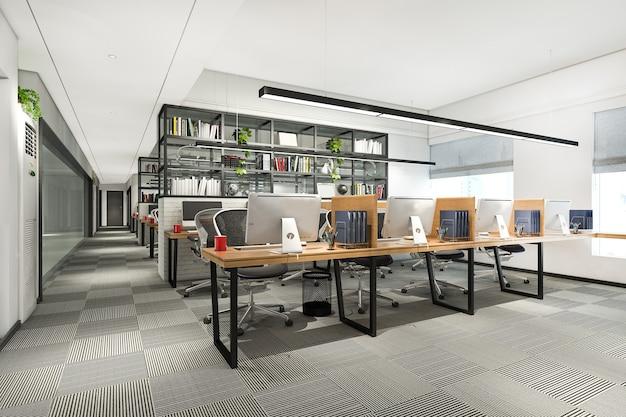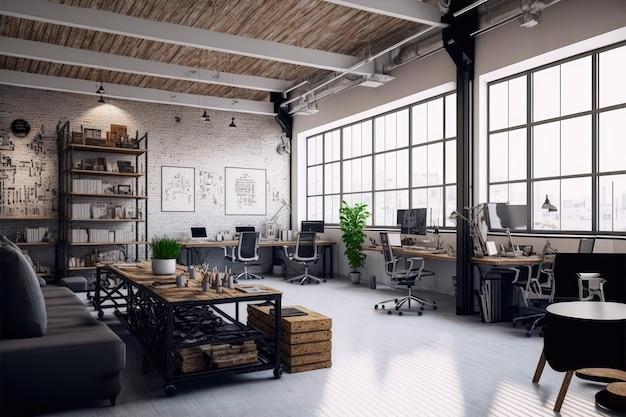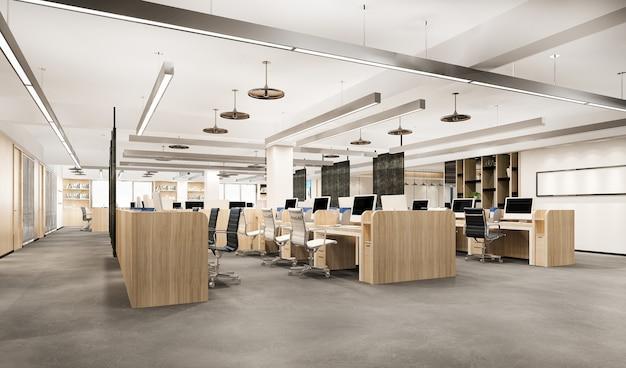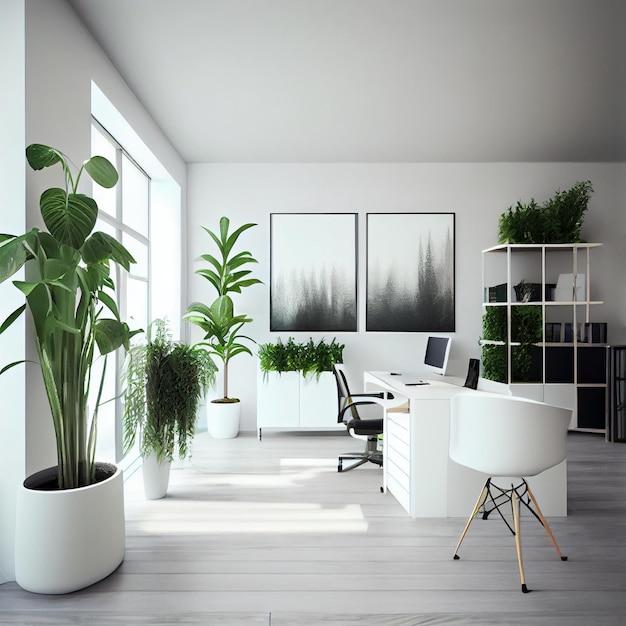As the world moves towards more remote working options and hybrid workplaces, companies are rethinking their office spaces to keep up with the changing times. Modern workplace design is more than just aesthetics. It significantly impacts employee productivity, creativity, and well-being.
In this blog post, we will explore the latest office design trends for 2023, taking into account the current pandemic situation and its effects on office design. From office color trends to corporate interior design, we will cover all the essential aspects of workplace design. Let’s dive into the four latest workplace trends, what makes a good workplace design, and the workspace trend for 2023.
Workplace Design Trends: Creating Spaces That Work for Everyone
The days of drab, uninspired office spaces are long gone. Today’s workplaces are focused on creating a comfortable and productive environment for employees. From open-plan offices to collaborative work areas and breakout spaces, companies are exploring new ways to optimize their workspace. In this section, we’ll take a closer look at the top workplace design trends that are shaping the way we work.
Embracing Employee Well-Being
One of the most significant changes we’ve seen in workplace design over the last few years is a focus on employee well-being. As companies realize the importance of supporting mental and physical health, they’re incorporating features like standing desks, ergonomic seating, and nature-inspired elements into office spaces. Beyond physical health, some workplaces also offer mental health support programs, like counseling and meditation spaces.
Collaboration is Key
The days of working in isolation are long gone. Collaboration has become a vital aspect of modern workplaces, so it’s no surprise that many office spaces are designed to foster teamwork. From open-plan workspaces to shared workstations, collaborative spaces encourage communication and idea-sharing. Additionally, many offices now have designated areas for team meetings and brainstorming. These spaces are designed to be flexible and adaptable so that teams can quickly shift between individual work and group collaboration.
Aesthetics Matter
Gone are the days when offices were simply functional spaces. Today, companies are investing in aesthetically pleasing office design to boost employee morale and productivity. Natural lighting, vibrant colors, and unique artwork can create a welcoming and inspiring environment. Office spaces are no longer dull and drab; they’re now vibrant and dynamic places that employees look forward to spending time in each day.
Smart Technology
As technology continues to advance, workplaces are using it to streamline operations and improve productivity. Smart technology, such as sensors that adjust lighting and temperature based on occupancy, can help optimize workspaces. Additionally, digital collaboration tools and wireless charging stations are becoming commonplace.
Sustainability
Finally, sustainability is becoming increasingly crucial in modern office design. Companies are exploring ways to reduce their carbon footprint and incorporate eco-friendly elements into their workspaces. This includes everything from sustainable building materials to energy-efficient appliances and waste reduction programs.
In conclusion, there’s no question that workplace design is evolving at a rapid pace. As companies recognize the importance of employee well-being, collaboration, aesthetics, technology, and sustainability, they must adapt their workspaces accordingly. By embracing these trends, companies can create spaces that work for everyone, resulting in happier and more productive employees.
Modern Workplace Design
Do you remember the good old days when offices were traditional, dreary, and uninspiring? Well, say goodbye to those soulless times because modern workplace design is here to save us from boredom and monotony!
Out with the Old, In with the New
At the heart of modern workplace design is the concept of innovation. Modern workplace design trends aim to break down traditional structures and create open workspaces that encourage collaboration, creativity, and well-being. Think open floor plans, plenty of natural light, and lots of greenery.
Bye-bye, Cubicles
Gone are the days when employees were chained to cubicles. The modern workplace design encourages flexibility in workspace. It incorporates movable desks and chairs to increase mobility and lets employees work from whatever location they choose to be in. From lounge areas for relaxation to outdoor workspaces, the modern workspace has it all.
Work Hard, Play Hard
A modern office isn’t just a place for work, it’s also a place for play. More and more workplaces are incorporating features like in-house coffee shops, gaming areas, and yoga studios. These facilities are designed to help employees relax and recharge their batteries during the day.
Functionality and Creativity
Office design is not just about aesthetics; it has to be functional too. A modern workspace design incorporates functionality with creative design elements. For instance, modern furniture is both ergonomic and stylish. Also, the modern workplace should always offer pleasant and comfortable surroundings that enhance employee productivity.
As the modern workplace design continues to evolve steadily, forward-thinking companies staying with the times are riding the wave to a brighter future.
Office Color Trends 2023
As we enter 2023, workplace design continues to evolve, and it’s not just about ergonomics and functionality anymore. Office color trends have become equally essential in shaping the perfect corporate atmosphere.
Punchy and Powerful
This year, companies are going bolder with their color choices, focusing on strong hues that create a bold impact. Deep blues and greens are contrasting against bright oranges and fiery reds, amplifying the energy of the workplace.
Rustic and Raw
2023 is all about bringing nature indoors, and rustic shades are taking over the corporate space. Think warm browns, earthy greens, and sun-kissed yellows. These natural colors are perfect for creating a relaxed and cozy ambiance, ideal for boosting employee morale.
Space for Creativity
In an industry where creativity is of the utmost importance, companies are choosing to decorate their offices with eye-catching colors. Expect to see splashes of neon, pink, and pastel colors to help stimulate the creative mind.
Dreamy Pastels
Pastels continue to reign supreme in office decor, and we don’t see them going anywhere any time soon. These soft colors create a calm, relaxed, and inviting atmosphere to make employees feel at ease and in the zone.
With these new office color trends for 2023, your workspace will feel like a breath of fresh air. Don’t be afraid to mix and match, show your creativity, and try new things. Just make sure that the colors and palettes you choose reflect the values and identity of your company.
Office Design Trends Post COVID-19
The COVID-19 pandemic shook up the world and had a dramatic impact on the way we work. Suddenly, workers around the world found themselves forced to work remotely, leaving offices empty and gathering dust. Now, as we start to think about returning to the office, we need to consider how office design trends have changed since COVID-19.
Prioritizing Health and Safety
One of the fundamental changes that COVID-19 has brought about is a new focus on health and safety. We now know that the virus can spread easily in enclosed spaces like offices, so businesses need to take extra precautions to protect their employees. This means things like installing better ventilation systems, enforcing social distancing, and providing hand sanitizer throughout the office.
The Rise of Remote Work
Another major trend that we’ve seen since COVID-19 is the rise of remote work. Before the pandemic, many companies were resistant to allowing their employees to work from home. However, as we’ve seen over the last year, remote work can be just as productive (if not more so) than working in the office. As a result, many businesses are adopting a hybrid model that allows employees to work both in the office and from home.
Designing for Flexibility
With remote work on the rise, many companies are starting to think about how they can make their office spaces more flexible. For example, businesses might choose to implement hot-desking, where employees don’t have assigned seats but simply find a free desk when they come into the office. This can help to reduce the amount of space that a company needs, which can be a cost-saving measure.
Rethinking Collaboration
Finally, COVID-19 has caused us to re-evaluate how we collaborate with our colleagues. Many businesses relied heavily on face-to-face interactions in the past, but now that we’ve seen how easily the virus can spread, we need to think about more innovative ways of working together. This might mean using video conferencing software to hold virtual meetings, or investing in collaboration tools that make it easier for teams to work together remotely.
All in all, COVID-19 has caused a seismic shift in the way we think about office design. As we move forward, businesses need to be open-minded and flexible, and willing to embrace new working practices that prioritize the health and safety of their employees.
What are the Four Workplace Trends
The workplace has undergone significant changes in the past decade, and the design of office spaces has not been left out. Here are four of the most significant workplace design trends that have emerged in recent years.
Flexible Workspaces
The traditional office setup has given way to more flexible spaces that can adapt to the varying needs of employees. A flexible workspace may include open areas, private spaces, and rooms for collaboration. The idea is to create an environment that fosters creativity, innovation, and communication.
Sustainable Design
In recent years, office design has shifted towards sustainability, which refers to the incorporation of eco-friendly elements in the workspace. These elements may include the use of energy-efficient lighting and HVAC systems, the installation of solar panels, and the use of recycled materials. Sustainable design not only benefits the environment, but also helps to increase employee morale and productivity.
Technology Integration
Advancements in technology have made it possible for workplaces to integrate technology into the design of their spaces. This can include technological tools such as video conferencing, telepresence, and virtual reality. Technology integration has helped to streamline communication and increase productivity in the workplace.
Wellness-Centered Design
The importance of employee wellness has been recognized in recent years and has given rise to wellness-centered design. This design trend involves creating work environments that prioritize the physical, mental, and emotional well-being of employees. Amenities such as standing desks, ergonomic chairs, and fitness centers have become commonplace in modern office spaces.
In conclusion, workplace design trends are constantly evolving, and it is important for companies to stay up-to-date with the latest trends to remain relevant and competitive. By incorporating flexible workspaces, sustainable design, technology integration, and wellness-centered design, companies can create a work environment that fosters creativity, collaboration, and productivity.
What Makes a Good Workplace Design
When you think about it, people spend the majority of their adult life in work environments, which is why a great workplace design is important! Here are some features that make for a productive and happy workplace:
Comfortable Furniture
If you’re going to spend most of your day sitting, then make sure your chair is comfortable! Your desk and workstation should also be ergonomically designed to prevent discomfort and potential injuries, such as carpal tunnel.
Natural Light
No one wants to work in a dark cave all day. Natural light boosts mood, productivity, and creativity, so make sure your workplace has plenty of windows and natural light sources.
Clear Layout
A cluttered and confusing layout can be stressful and frustrating, leading to decreased productivity and low morale. Ensure that the workspace layout is easy to navigate and visually appealing.
Collaborative Spaces
Gone are the days of cubicles and isolated workstations. The workplace should have collaborative spaces where employees feel comfortable sharing ideas and collaborating.
Break Areas
Breaks are important for productivity and mental health. Make sure there are areas designated for breaks where employees can relax and recharge.
Adequate Technology
Outdated technology can be frustrating and slow down productivity. Invest in up-to-date technology tools that are essential for a productive workplace.
Personalization
Allow and encourage employees to personalize their workspaces to reflect their personalities. This helps them feel more comfortable and invested in their work environment.
In conclusion, a good workplace design is essential for a productive and happy workforce. Make sure the furniture is comfortable, there’s plenty of natural light and clear layout, collaborative spaces are available, break areas are present, the technology is up-to-date, and personalization is encouraged.
Workspace Trend in 2023: What to Expect
With the global pandemic wreaking havoc on the world, office spaces have recorded massive changes in work patterns and design. Companies across the globe have had to come up with innovative solutions to make workspaces comfortable, safe, and efficient for their employees. But what will the workspace trend be in 2023? Here are some resolutions to expect in the next few years.
Flexibility
One thing that is certain about the future of workspaces is flexibility. Companies are rethinking their approach to workspace through the cubicles and traditional setups as innovative, more efficient designs take center stage. Expect more offices to incorporate breakout zones, open spaces, and collaborative work areas unspecific to any department or individual.
Technology Integration
With remote work at the fore of workspace design, we expect technology to play a more significant role in determining office spaces’ design and functionality. Employers and employees will find it easy to work together in real-time, whether present physically or remotely. From cloud-based apps to IoT-powered tools, anticipate that the next workspace trend would be technology integration.
Customizable Space
Gone are the days when companies dedicated huge chunks of space to a single department or groups of employees. As they strive for efficiency, workplaces will employ the use of furniture and partitioning walls that are customizable. That way, companies can restructure or renovate spaces to fit their employees’ needs, increasing productivity and collaboration in the process.
Biophilic Elements
Biophilic design is a design that incorporates nature, plants, and other materials in a workspace, creating a serene, calm environment that improves employee wellness and productivity. As people spend more time indoors than outdoors, companies may include ‘green walls,’ plants, and other calming elements in the work environment to enhance employees’ health and reduce stress levels.
Hybrid Work Model
While remote work will continue to grow in popularity, a hybrid model of working, which allows employees to work remotely or work in an office for set hours in a day or week, will become the norm. Companies will have to balance physical and mental health concerns that arise from overworking remote employees while maintaining productivity levels and adapting to the upcoming workspace trend.
The future of workspace design is all about flexibility, technology integration, customizable space, biophilic elements, and hybrid work models. Offices that can absorb and embrace these workspace trends in 2023 and beyond stand to benefit from better productivity, a healthier workforce, and better staff retention rates.
Corporate Interior Design Trends to Watch Out for in 2023
As we approach 2023, the world of corporate interior design is evolving rapidly with new trends emerging, and old ones taking on fresh twists. A well-designed office space can be a game-changer for any business, helping employees become happier, more productive, and motivated. Here are some of the emerging corporate interior design trends to keep an eye on in 2023:
Smart Offices
Several companies are now looking at incorporating automation and AI into office spaces. From AI-powered voice assistants to smart lighting systems, these futuristic office spaces will be designed to be more efficient, safe, and eco-friendly. Imagine walking into an office that adjusts the lighting and temperature to suit your mood or having your smart assistant schedule meetings, order lunch, and book flights for you.
Biophilic Designs
Biophilic design is all about bringing nature into the workplace. This design trend involves incorporating natural elements such as greenery, water features, and natural light into the workspace. Studies have shown that biophilic designs can reduce stress, enhance productivity, and boost creativity among employees.
Flexible Workspaces
Flexible workspaces are a popular corporate interior design trend that is here to stay. These workspaces allow employees to move around and collaborate easily, irrespective of the type of work they are involved in. Employers are opting for modular furniture, movable walls and partitions, and flexible layouts that can adapt to different uses.
Sustainable Designs
Sustainability is becoming more important, and businesses want to reflect that in their office spaces. Eco-Friendly designs have moved beyond recycling bins and refillable water bottles; now, office spaces are also using renewable energy sources, such as solar and wind power, to run their operations. Design choices such as recycled materials, green walls, and energy-efficient lighting can make an office space more sustainable.
Colours and Textures
As businesses look to create a more welcoming and comfortable environment for their employees, more attention is being paid to colours and textures. Warm colours such as navy blue, mustard yellow, and deep reds provide a comfortable feel, while textures such as velvet and leather create a sense of luxury.
Conclusion:
The future looks exciting for corporate interior design in 2023. As businesses strive to create a welcoming, warm, and eco-friendly workspace with the latest technology and designer-inspired aesthetics, we can all look forward to strikingly modern and comfortable workspaces. By embracing these trends, businesses are not only creating a more attractive environment but also helping their employees reach their full potential.



